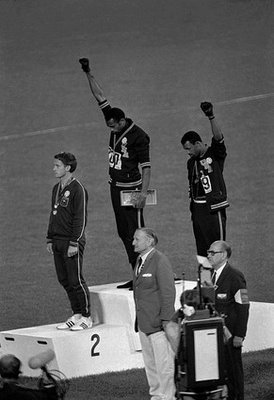
http://www.latimes.com/sports/la-sp-adande22oct22,0,1869393.column?coll=la-home-headlines
M&C note: this article is a great example of why this blog exists. This was an illuminating story, an excellent article, and I cannot find online anymore, anywhere. I think it deserves to be read. If anyone finds an updated link, please let me know.
LA Times
J.A. ADANDE
His place in history went hand in glove with theirs
J.A. Adande
October 22, 2006
Have you ever watched a movie for the 10th time and noticed something that you've never seen before? Did you wonder how you possibly could have missed it?
That's the way I felt when I learned that John Carlos and Tommie Smith flew to Australia to serve as pallbearers in the funeral of Peter Norman, the third man on the medal stand with them in that iconic photo of their black-gloved protest at the 1968 Olympics.
I'd stared at that photograph until its image was burned onto my retinas and I never registered Norman. I'd read every article I came across about Smith and Carlos, including an exceptional two-part Sports Illustrated series by Kenny Moore in 1991, and I didn't have a clue about the Australian sprinter who won the silver medal in that 200-meter race.
"Then you don't really know about the story," Carlos said.
It's a lesson in how a single moment of solidarity can lead to a lifetime bond. It's an inspiring example of how people from different races and different countries can find unity in what is right.
"It's important for this story to be told," Carlos said. "Regardless of what your ethnicity is, you have to play and will play a very important part of what this society is."
It started after the 200-meter race, which was won by Smith. Smith and Carlos, the bronze medalist, wanted to use their moment in the spotlight to protest discrimination against black people in America. They would wear black socks to the medal stand to symbolize the poverty afflicting so many black people. They wore gloves to symbolize black power and unity. They also wore buttons with the logo for activist Harry Edwards' Olympic Project for Human Rights. Norman wanted to be involved.
"I merely asked Mr. Norman, 'Do you believe in human rights?' " Carlos said. "He said, 'Yes.' "
Carlos borrowed an OPHR button from American rower Paul Hoffman and gave it to Norman. Norman wore it during the medal ceremony and stood still, arms by his side, while "The Star-Spangled Banner" played in honor of Smith's victory. As the song started, Smith's right arm went up, straight as a flagpole. Carlos raised his left arm, bent slightly at the elbow.
It's one of the enduring images of the 1960s. Today the picture can be found on posters, on T-shirts and all over the Internet. Before Norman died on Oct. 3, it wasn't so easy to find an accompanying caption that included his name. Sometimes he's cropped completely out of the photo.
When San Jose State, the alma mater of Smith and Carlos, commissioned a statue to honor the moment, Norman wasn't included. His spot on the platform was left empty. That didn't keep him from joining Smith and Carlos on campus for the unveiling last year.
Of the 13,809 words in that Sports Illustrated series, only 96 were used in sentences about Norman.
But to Carlos, Norman's show of support was an integral part of the experience. For a white man from Australia to figuratively stand beside two black Americans who were sure to catch fire went "beyond" the average individual, Carlos said.
"It was about having an understanding as to who we are and where we were trying to go as men," Carlos said.
At Norman's memorial in the Melbourne suburb of Williamstown, Carlos expressed admiration for Norman's resolve, even when facing criticism in Australia. Like Smith and Carlos, Norman's post-Olympic life was challenging: His first marriage ended, an infection nearly led to amputation of a leg and he battled alcoholism.
"He never flinched," Carlos said. "He never reneged. He never denied us. He never said, 'Ouch.'
"He was stern about what he stood for. I respect him and love him for the rest of my life, as much as I did the first time I looked in his eyes. I think it was a divine moment, a spiritual moment from God to set a precedent for the world to see — even though they have never told the story."
Norman's nephew, Matt Norman, is bringing the tale to the big screen with a movie called "Salute — The Peter Norman Story" that he hopes to get into the Sundance film festival. (Carlos said he has met with Imagine Entertainment regarding a movie about his and Smith's saga. Through an intermediary, Imagine President Michael Rosenberg said he had not heard of the project.)
Matt Norman said that he would honor his uncle's memory by donating a portion of his movie's profits to Hurricane Katrina victims in New Orleans. You've seen those New Orleans pictures. You know most of those faces look nothing like Peter Norman.
It's not always about making decisions based on surface similarities. It's about looking deeper and doing what's right. That's what we can take from Norman's 64 years on the planet. That's what inspired the 61-year-old Carlos to take time off from his counseling job at Palm Springs High and take a 14-hour flight to Australia for the funeral.
"I think Peter would have done no less had it been John Carlos in that box," Carlos said. "I was compelled. I had to be there."
He and Smith helped carry Norman's coffin out of the service, and said a final goodbye.
"You say, 'Man, that's the end of Peter Norman's life on this earth,' " Carlos said. "His history will go on."
For people like me, it's just beginning.

No comments:
Post a Comment